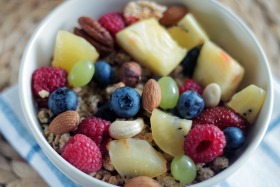Take Control of Your Blood Sugar Now!
By: California Center of Longevity & Functional Medicine on September 30, 2015
Out of control blood sugar levels can lead to serious short term problems such as hypoglycemia, hyperglycemia, or diabetic ketoacidosis.
In the long run, uncontrolled blood sugar can also damage the vessels that supply blood to important organs, like the heart, kidneys, eyes, and nerves. This can occur even when you feel OK.
Follow these 13 Steps to help in Controlling Your Blood Sugar:
-
 Eat a balanced breakfast every morning. This will help ensure you do not start the day in a hypoglycemic state. Eat a balanced breakfast every morning. This will help ensure you do not start the day in a hypoglycemic state.
-
Consume balanced meals and healthy snacks throughout the day. As opposed to skipping meal, this approach will help your blood sugar steady and metabolism running efficiently. Ask your doctor if a change in meal timing or frequency is required to help you maintain better glucose control.
-
Eat mixed meals or snacks of protein, carbohydrate and fat. Eaten alone, carbohydrates will often cause an increase in the insulin response. Conversely, when eaten as part of a protein-based, high fiber meal, the glycemic response (fluctuations in blood sugar levels) is generally lower.
-
Avoid refined carbohydrates and simple sugars. Items such as candy, sodas, cakes, desserts and juices have a high glycemic index, which cause a rapid rise in glucose. White bread, white rice and white sugar are refined food products. Whole grains such as wild rice, millet, quinoa, brown rice, and amaranth are healthy whole-grain options high in fiber and B vitamins. See Glycemic Index Food List for additional information.
-
Eat protein at every meal. Protein sources low in saturated fat include legumes (beans, peas, and lentils) eggs, white meat chicken, turkey, wild game, and low fat dairy. Legumes contain significant amounts of fiber, which helps to slow the release of glucose into the bloodstream. Fiber also helps detoxify the intestines by removing toxins.
-
Eat a serving (3 ounces) of fish 2-3 times a week. Certain types of fish (salmon, mackerel, tuna, herring and sardines) and flax oil are high in omega-3 fatty acids, a type of fat that is highly effective for restoring normal insulin sensitivity. In addition to providing omega-3 fatty acids, fish is an excellent source of protein. If you are a vegetarian, or cannot consume fish, excellent vegetarian sources of omega-3 fatty acids include ground flax seeds, flax seed oil (keep refrigerated), chia seeds, hemp seeds, sesame seeds, walnuts and Brussels sprouts.
-
Eat foods high in fiber. Fiber helps slow the absorption of glucose into the bloodstream. Hard-shelled beans such as black beans, kidney beans, navy beans, and chickpeas are high in fiber. Adding at least a half cup of beans to a meal will significantly boost your fiber intake. Other foods high in fiber include fruits, vegetables, nuts and seeds.
-
Avoid saturated fat or processed foods that have anon their labels "hydrogenated" or "partially hydrogenated" vegetable oils. These fats have a negative impact on how the body uses insulin. Hydrogenated fats, or trans fats, are commonly used in packaged good including margarine, shortening, French fries, doughnuts, cookies and crackers. You can determine the amount of trans fats in a product by looking at the Nutrition Facts Panel.
-
Each meal should contain a healthy source of fat. Healthy monounsaturated and polyunsaturated fats can be included in your diet by using cold-pressed extra virgin olive oil, and sesame (tahini), flax, walnut, almond, grapeseed, and avocado oils. For medium-heat cooking, use olive oil. Flax oil can be used to top salads or any other cold dishes and should be kept refrigerated (Flax oil should never be heated). Avocado and olives are also delicious ways to add healthy fats to your daily meals.
-
Limit the consumption of starchy vegetables. Starchy vegetables such as potatoes, corn (including popcorn), carrots and peas can cause rapid increase in blood sugar. Instead, be sure to include several daily servings of colorful vegetables, including yellow and green. Most vegetables are low in calories and have a minimal effect on blood sugar. Colorful vegetables are also high in antioxidants.
-
Drink adequate amounts of liquids to keep your body hydrated. Water, seltzer, mineral water, and herbal, decaffeinated or green tea will help keep you hydrated, without affecting blood sugar levels.
-
Avoid artificial sweeteners. Many artificial sweeteners are marketed as containing zero sugar. However, they may also be toxic to the brain. Natural sweeteners that do not contain sugar may contain toxic chemicals include stevia, xylitol and erythritol.
-
Be sure to exercise regularly. A sedentary lifestyle is a major contributor to diabetes and heart disease. Physical activity helps maintain insulin sensitivity, blood glucose and muscle mass, and produces chemicals that promote relaxation.
Dr. Allan Kurtz specializes in creating optimal health and wellness longevity plans for his patients. He is fellowship trained in Integrative Medicine as well as Functional Medicine. He is also a member of the American Academy of Anti-Aging Medicine and The Institute for Functional Medicine. He founded the California Center of Longevity & Functional Medicine in Woodland Hills, CA in order to help you to maintain, and/or restore your optimal health.
To schedule a consultation and begin planning for integrative wellness & longevity health, contact us today at 818.346.1440
|






 Eat a balanced breakfast every morning. This will help ensure you do not start the day in a hypoglycemic state.
Eat a balanced breakfast every morning. This will help ensure you do not start the day in a hypoglycemic state.